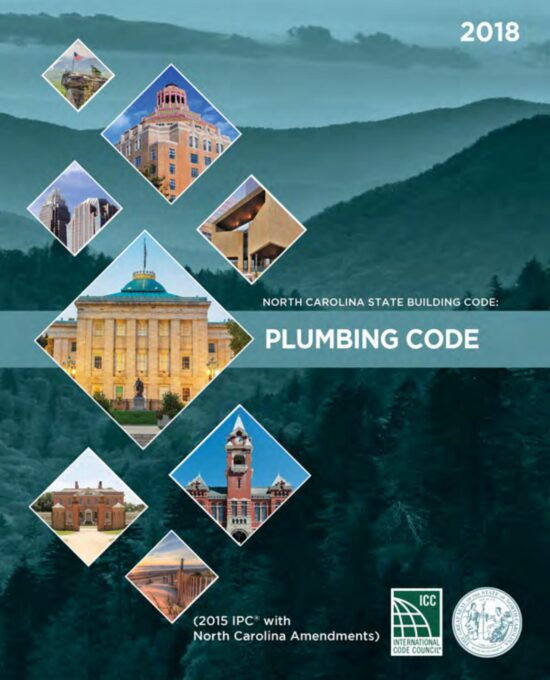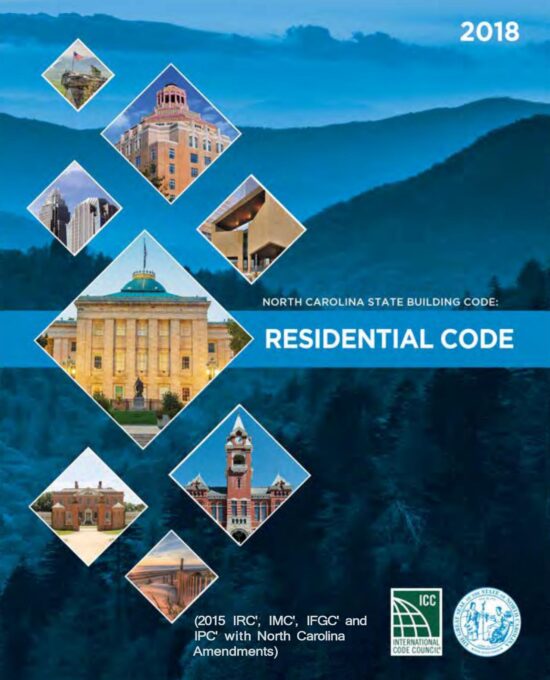2018 North Carolina State Building Code: Plumbing Code
The 2018 North Carolina State Building Code: Plumbing Code (NCPC) integrates the 2015 International Plumbing Code® (IPC) with North Carolina-specific amendments to ensure code-compliant design and installation of plumbing systems throughout the state. It covers all essential aspects of water supply, sanitation, and drainage to support public health and building safety.
Highlights:
- Incorporates 2015 IPC® with state-specific modifications for local relevance
- Establishes performance and prescriptive standards for plumbing systems
- Covers potable water, sanitary drainage, storm drainage, and venting systems
- Defines fixture requirements and installation guidelines for all occupancies
- Addresses healthcare plumbing, backflow prevention, and pipe sizing
- Includes Appendices C and E on structural safety and water piping system sizing
- Coordinates with related codes such as building, mechanical, and fire codes
Who It’s For:
Architects, plumbing contractors, engineers, and building inspectors who require a clear, enforceable standard for plumbing work in North Carolina's built environment.
NCPC-2018
2018 North Carolina State Building Code: Plumbing Code
The 2018 North Carolina State Building Code: Plumbing Code (NCPC) integrates the 2015 International Plumbing Code® (IPC) with North Carolina-specific amendments to ensure code-compliant design and installation of plumbing systems throughout the state. It covers all essential aspects of water supply, sanitation, and drainage to support public health and building safety.
Highlights:
- Incorporates 2015 IPC® with state-specific modifications for local relevance
- Establishes performance and prescriptive standards for plumbing systems
- Covers potable water, sanitary drainage, storm drainage, and venting systems
- Defines fixture requirements and installation guidelines for all occupancies
- Addresses healthcare plumbing, backflow prevention, and pipe sizing
- Includes Appendices C and E on structural safety and water piping system sizing
- Coordinates with related codes such as building, mechanical, and fire codes
Who It’s For:
Architects, plumbing contractors, engineers, and building inspectors who require a clear, enforceable standard for plumbing work in North Carolina's built environment.
NCPC-2018
2018 North Carolina State Building Code: Residential Code (NCRC)
The 2018 North Carolina State Building Code: Residential Code (NCRC) is the official standard for the design and construction of one- and two-family dwellings and townhouses across North Carolina. Adapted from the 2015 International Residential Code® (IRC), it incorporates state-specific amendments to ensure alignment with local building practices, safety regulations, and environmental considerations.
Highlights:
- Based on the 2015 IRC with North Carolina-specific modifications
- Applies to detached one- and two-family dwellings and townhouses not more than three stories
- Covers building, plumbing, mechanical, fuel gas, and energy provisions
- Provides requirements for foundations, framing, roofing, insulation, and fire safety
- Supports code enforcement with clearly defined compliance pathways
- Aligned with local climate zones and hazard considerations
- Enables consistency in residential permitting and inspection
Who It’s For:
Homebuilders, residential contractors, designers, code officials, and inspectors involved in residential construction in North Carolina.
NCRC-2018
2018 North Carolina State Building Code: Residential Code (NCRC)
The 2018 North Carolina State Building Code: Residential Code (NCRC) is the official standard for the design and construction of one- and two-family dwellings and townhouses across North Carolina. Adapted from the 2015 International Residential Code® (IRC), it incorporates state-specific amendments to ensure alignment with local building practices, safety regulations, and environmental considerations.
Highlights:
- Based on the 2015 IRC with North Carolina-specific modifications
- Applies to detached one- and two-family dwellings and townhouses not more than three stories
- Covers building, plumbing, mechanical, fuel gas, and energy provisions
- Provides requirements for foundations, framing, roofing, insulation, and fire safety
- Supports code enforcement with clearly defined compliance pathways
- Aligned with local climate zones and hazard considerations
- Enables consistency in residential permitting and inspection
Who It’s For:
Homebuilders, residential contractors, designers, code officials, and inspectors involved in residential construction in North Carolina.
NCRC-2018

